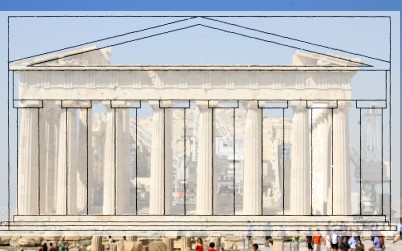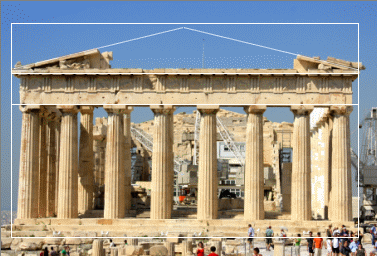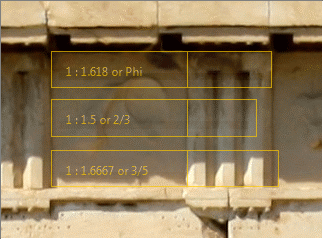The Parthenon
View FullscreenIktinas and Kallikrates (architects) and Phidias (sculptor) (Greek), The Parthenon, 447-432 BCE. Limestone and marble. Athens, Greece.
Does the Parthenon deserve its status as a canonical example of the Golden Ratio in art?
Countless images of the Parthenon superimposed with Golden Ratio lines abound online and in historical references. In fact, this ancient Greek temple is such a pillar of Golden Ratio lore that the Greek letter associated with the ratio, Phi, comes from the name of the Parthenon’s sculptor, Phidias.
Believers note that the proportions of the façade (height as measured from platform to base of pediment) make it a golden rectangle. David Bergamini, Malcolm W. Browne, Francis S. Hill, Jr., H.E. Huntley, George Manuel, James Mitchell, and Theoni Pappas are among the scholars who support this claim. In his Divine Proportion (1970), Huntley writes: “While [the Parthenon’s] triangular pediment was still intact, its dimensions could be fitted almost exactly into a Golden Rectangle, as shown above [see below]" (63).
[image from Huntley]
But skeptics like mathematician George Markowsky counter that such measurements are arbitrary, and that “none of these authors is bothered by the fact that parts of the Parthenon are outside the golden rectangle” (Markowsky, 8). He points out that “different authors are measuring between different points” to come to affirmative conclusions, and that the closest ratio to Phi is 1.72, significantly different.
Marco Livio echoes Markowsky’s subjectivity-related doubts when he points out that “the dimensions of the Parthenon vary from source to source, probably because different reference points are used in the measurements” (74).
In a February 2016 essay subtitled "Debunking the debunkers of Golden Ratio Myths," Gary Meisner systematically defends eight Golden Ratio claims against Markowsky's attacks. He provides visual evidence showing that Markwosky manipulated the dimensions of his Parthenon diagram in order to reject the idea that it fits into a Golden Rectangle.

Markowsky illustration overlaid onto Parthenon photo
Note, however, that the top horizontal in Meisner's own diagram is not flush against the top of the pediment, and he provides no explanation for his choice of placement for the bottom horizontal.

Meisner also writes, REASONABLY, that scholars should not concentrate on the outside frame of the Parthenon at the risk of ignoring, as Markowsky did, architectural design elements that conform to Phi:

Without supporting documentary evidence, we cannot definitively confirm that Iktinos, Kallikrates, and Phidias consciously employed the Golden Ratio in their architectural and sculptural designs. Note that the first known mention of this proportion does not occur until over a century later, with Euclid's description of the "extreme and mean ratio" in his Elements.